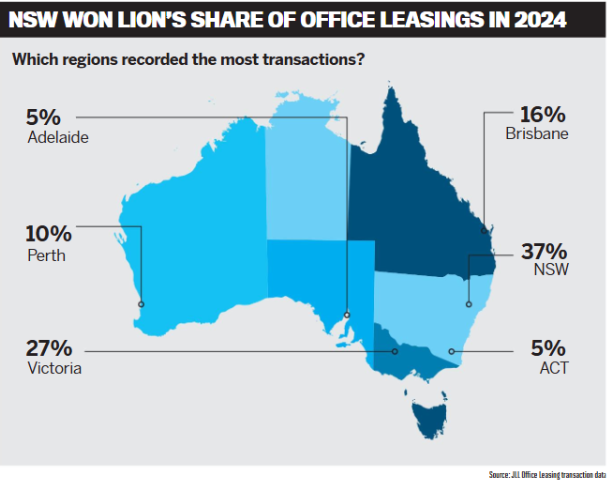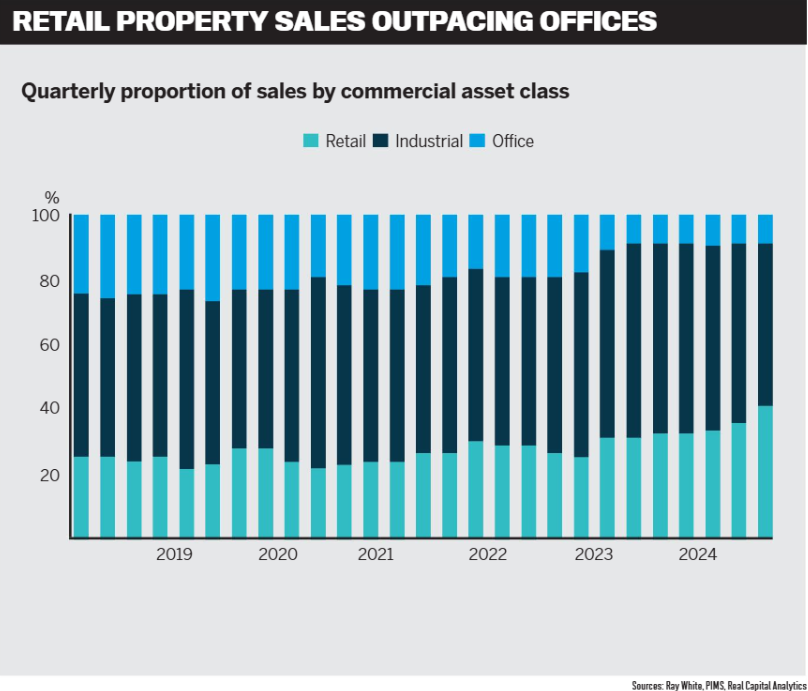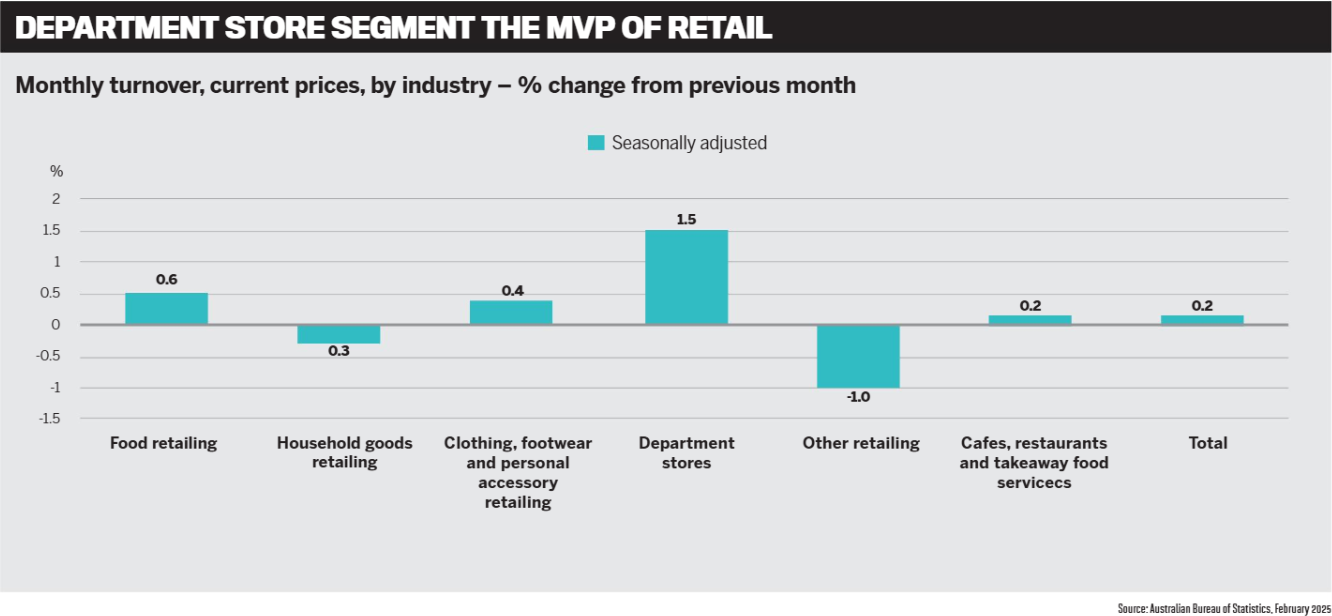Australia's biggest banks are seeing a flight to quality in the commercial office space and a mixed bag of sentiment in the retail sector

Few would accuse Australia’s commercial property market of going gangbusters right now. Commercial office vacancy rates remain in the mid-to-high double digits, and while the trend line is moving in the right direction, returning to pre-COVID vacancy rates of 9% and less feels like wishful thinking.
Yet while the country’s capital cities continue to battle the post-pandemic headwinds, ANZ’s associate director of property, Daniel Gradwell (pictured above left), has observed a bounce-bank in 2024/25.
“Sentiment appears to have improved quite significantly over the past year in the CBD retail space,” Gradwell tells MPA.
The slow and steady march of city workers back to the office alongside “a sizeable rent adjustment” has made for a more attractive environment for businesses to start up in, he adds.

“It’s getting there,” Gradwell says of commercial office property. “Return-to-office mandates are increasingly widespread, but the return is still sluggish in Sydney and Melbourne. Rents are now stabilising, but vacancy rates remain high across these cities, although it should be noted that the likes of Brisbane, Perth and Adelaide are faring much better.
“But there is still a great deal of uncertainty around the outlook, which is weighing on confidence in the office sector.”
Gradwell highlights environment, social and governance (ESG) as another factor that’s driving uncertainty in the commercial office space. He says, “Most government tenants, and many large corporates, are now only signing new leases for highly energy-efficient buildings, which is driving demand in the higher-end prime sector.
“On the other hand, secondary stock needs to take into account the likely tenant profile when current leases expire, and understand any potential renovation/uplift costs involved, heightening the risk profile of the segment.”
NAB’s executive commercial broker and equipment finance sales head, Chris Thomas (pictured above centre), pointed out that sentiment turned positive for office property for the first time in three years in the fourth quarter of 2024. Confidence was particularly high in SA and the NT but remained exceptionally low in Victoria.
“The recent RBA interest rate reduction has been well received by borrowers in this sector, and, with further cuts forecast, we are optimistic for further improvements in sentiment,” says Thomas. “The financing opportunity in retail property remains customers with current, or projected, quality tenancy profiles. Capacity to borrow continues to be determined by the cash flows derived from their rental schedules, underpinned by performing retail tenants.”
The real rebound in confidence is undoubtedly occurring outside of the city centre. Gradwell says, “We continue to see strong levels of demand for neighbourhood shopping centres, which are somewhat protected from economic volatility due to the presence of large anchor tenants [Coles, Woolworths] and the non-discretionary retailing on offer.”
Strip malls, however, remain softer due to the influence of online retailing. Gradwell notes that there are high vacancy rates across a number of strip retail locations, “providing a challenge for potential transactions.” 
In regional terms, Southeast Queensland “remains very active,” according to Gradwell. This aligns with the wider state’s overall outperformance in growth, both economically and in terms of population. “Importantly, this story is no longer about Brisbane … The Gold Coast in particular is benefiting from increased comfort around the stability of the local market, both from locals as well as interstate developers and investors.”
Biggest roadblocks
Construction costs and skills shortages “are absolutely still a roadblock” to getting projects up and running, particularly in the residential segment, says Gradwell. “The root cause of both of these issues largely comes back to the incredible volume of publicly funded infrastructure currently under construction around the country.
“While these multibillion-dollar road and rail projects are largely necessary – and in many cases should have been built decades ago – they tend to vacuum up a lot of the available resources and labour. This increases the cost base for other projects and makes it harder for builders to attract and retain the necessary workers and skills.”
There is unfortunately no easy solution to the problem, Gradwell concedes, “given the infrastructure projects generally take a number of years to reach completion, and upskilling a younger workforce similarly takes time.”
Developer customers are telling Thomas that the housing construction sector remains under pressure, influenced by factors like presales, regulation and higher construction costs.
“Notwithstanding this, and noting the current chronic undersupply of new dwellings, NAB is actively working with developers on finding solutions that can work,” he says.
Road to diversification
Diversification is on everyone’s lips in the mortgage finance space. Primarily a customer-driven trend, the emphasis has been on retaining customers by offering the full suite of financing options – not least commercial property.
For mortgage brokers, this means either hiring in top commercial talent or establishing a robust referral network to keep borrowers satisfied.
In many ways, it’s a natural evolution of the market. According to the latest government data, there are currently more than 800,000 sole operators in Australia. Most already use brokers for their home loans and are seeking the convenience of a one-stop financing shop for their business needs.
The opportunities are immense for brokers: while the third party channel commands more than 75% of the home loan market, its share is closer to 40% in the commercial finance space. That equates to some $60 billion in commercial loans still written directly by banks.
“Yes, we have already seen an increase in commercial property finance transactions introduced through the broker channel,” says Andrew Muller (pictured above right), senior broker manager at ANZ. “From a product diversification perspective, commercial property is a great introduction to commercial lending and can be a natural progression for mortgage brokers.
“As brokers become confident and competent in commercial property, they may then further diversify into other commercial lending opportunities.”
Muller sees the groundswell in broker diversification as a positive trend, highlighting that around 30% of the existing mortgage broker client base are likely to be self-employed.
“Diversification is a sound option for brokers to reduce the risk of concentrating on one income stream, and it’s a great way to broaden your client base,” he says.
However, he does see some common mistakes made when brokers first enter the commercial lending space. Deals are often more complex than a standard home loan, yet brokers don’t always engage and workshop with bankers to get the deal across the line.
Muller highlights that the regulatory environment may be simpler than in home lending, but “borrowing requirements are generally bespoke in nature to suit the business, its cash flow requirements and capital position.”
“Investing in your professional development to build your commercial knowledge and skill set is crucial,” he adds. “Partnering with an ANZ Broker Account Manager and working with our bankers will help build your confidence and knowledge.”
While commercial property deals can be more complex, Muller stresses that many of the fundamentals are the same as for residential. “They are both bricks and mortar – land is the main component, and location is critical,” he says.
Thomas says, “Now is the perfect time for brokers to support business customers with their banking needs. To be truly effective, brokers must go beyond commercial property lending and assist clients with a range of challenges, including growth, consolidation, and change.”
He sees 2025 as a landmark year for commercial brokers to strengthen long-term partnerships with their clients “by guiding businesses through the current market cycle and positioning them for future success.”
We believe there will be further investment by many broker firms in commercial broking, and this will attract more finance professionals with the right skill set to the industry,” he adds.
Market megatrends
According to NAB’s Market Megatrends 2024: Navigating the Future report, there are six long-term themes shaping Australia’s markets and broking environment: housing accessibility; intergenerational wealth transfer; businesses investing for growth and decarbonisation; property investment; advances in technology; and an increasing need for cybersecurity.
“Each of these areas presents commercial brokers with opportunities to work with business customers,” says Thomas. “For example, commercial brokers working with developers can help to unlock access to funding that supports an increase in housing supply to alleviate housing accessibility challenges Australia is facing.”

Further NAB research shows that nearly six in 10 SMEs are planning to invest and expand in the coming months. Thomas says, “Businesses in some sectors are thriving, while others are finding conditions more challenging. In this environment, brokers can add real value by deeply understanding business customers and helping them to secure the finance they need to be successful.”
Thomas touts NAB’s education and training programs, including face-to-face credit skills workshops running through May, as ways the bank works to forge stronger ties with brokers.
“As Australia’s largest business bank, the strength of our relationships enables us to support brokers in meeting all their customers' lending needs,” he says.



